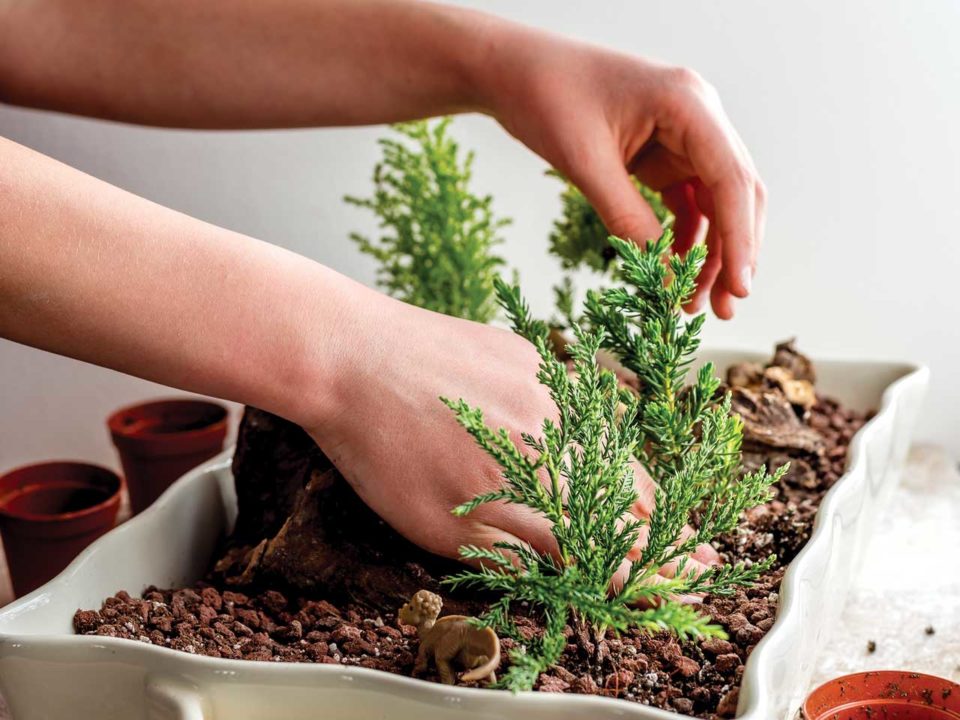Kids love dinosaurs! In the new book, Tiny Dino Worlds from Christine Bayles Kortsch—a Denver mom of two boys and regular workshop leader at Denver Botanic Gardens—dino enthusiasts get 26 hands-on projects for prehistoric terrariums, complete with suggestions for living plants and tiny dinosaurs to roam the space. Dig into this project from the book, and see what dino-mite new facts the kids pick up.
Forest Floor Terrarium
Imagine you’re walking through a quiet forest. Tall trees surround you on all sides. Look up and feel warm sunlight filtering down through a canopy of leaves. Now stoop down and look carefully at the forest floor. Notice how the ground feels soft and spongy under your feet. That’s because it’s covered with rotting leaves and new sprouts. The forest is constantly breaking down things that have died or decayed and turning them into nutrients for new life. Forests are also full of animals. Those animals poop every day. As you build a thick forest terrarium for your “good mother lizard,” the Maiasaura, don’t forget to include homemade coprolites (dino poop). Watch your step!
Materials & Tools:
- 1 container (glass, hard plastic, ceramic, or wood with a liner)
- Pea gravel, aquarium gravel, or small pebbles
- Potting soil
- 3 to 5 miniature evergreen plants
- Decorations of your choice: sticks or small branches, tiny pebbles for eggs, pine cones, rocks, moss, blue glass beads, feathers, leaves
- Toy dinosaur(s), miniature size (plus a regular size for the “mother,” optional). Look for a Maiasaura, but you can also substitute an Iguanodon, helmet-crested Corythosaurus, Parasaurolophus, or Hypacrosaurus
Tip: This forest terrarium needs abundant sunshine. Aim to water about once a week, when the soil is dry to the touch. Watch carefully, and in a few months you’ll notice your miniature forest has grown taller.
Directions:
1. If possible, wash your container with soap and hot water before starting. If you can’t wash it, then wipe it clean with a rag. Cover the bottom of the container with a ½-inch layer of pebbles or gravel and a thin layer of potting soil.
 2. Pop your plants out of their plastic liners and arrange them in the container. Pour soil around the roots, pushing down gently with your fingers to hold the plants in place. Add more soil until the soil level reaches the base of the plants.
2. Pop your plants out of their plastic liners and arrange them in the container. Pour soil around the roots, pushing down gently with your fingers to hold the plants in place. Add more soil until the soil level reaches the base of the plants.

3. There’s more to a forest than trees. What about some fallen logs, a stream, or pond made out of blue glass beads, or a cave shaped from rocks and moss? Look around your terrarium. If you were a Maiasaura, where would you build the safest, coziest nest? What materials would you use? Have fun building a cozy nest with feathers, moss, or leaves. And don’t forget the coprolites!
 4. Set your dinosaur toys into the habitat you’ve created and act out a scene. If you’d like to include a Maiasaura mother and baby, include both a regular-sized dinosaur toy and a miniature one.
4. Set your dinosaur toys into the habitat you’ve created and act out a scene. If you’d like to include a Maiasaura mother and baby, include both a regular-sized dinosaur toy and a miniature one.
Plant Picks
The earliest known conifers appeared around 300 million years ago, before the Triassic Period began. Conifers are gymnosperms, which means they have cones. Conifer trees still live today. While the earliest conifers looked different from modern ones, they were the ancestors of the pine, spruce, fir, and other evergreen trees you see in the forest today.
Check out the terrarium or bonsai section of a well-stocked nursery and you’ll find lots of wonderful plants that look like tiny conifer trees. Compact fernspray cypress (Chamaecyparis obtusa ‘Filicoides Compacta’), miniature common spruce (Juniperus communis ‘Miniature’), and dwarf Atlantic white cedar (Chamaecyparis thyoides ‘Top Point’) are all fun choices. Miniature lemon cypress (Cupressus macrocarpa ‘Goldcrest’) is special. Rub the leaves gently between your fingers and you’ll breathe in a delicious lemon scent.
From Tiny Dino Worlds by Christine Bayles Kortsch © 2020 Christine Bayles Kortsch. Reprinted in arrangement with Roost Books, an imprint of Shambhala Publications, Inc. Boulder, CO.






